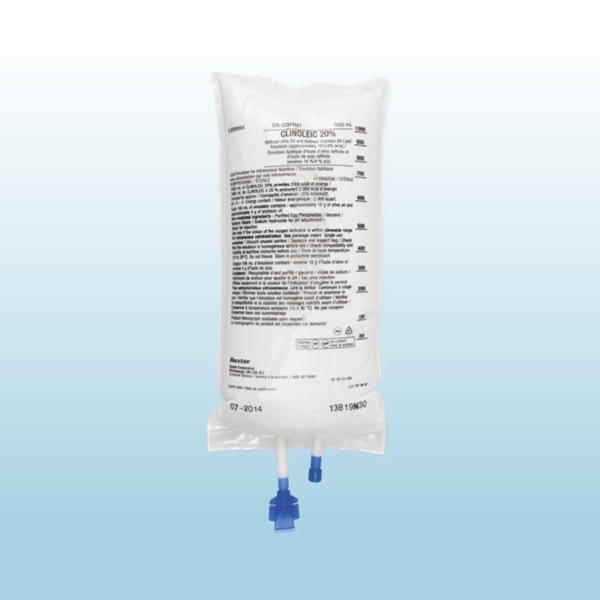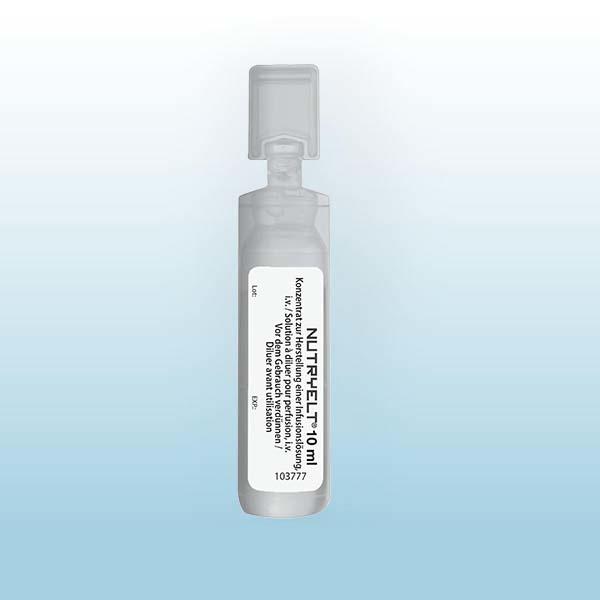Clinimix
Portfolio of dual-chamber ready-to-use parenteral nutrition (PN) products designed to offer a range of amino acid and dextrose combinations while meeting the basic amino acid and energy needs of patients.

With over 25 years of experience, Clinimix dual-chamber bags enable clinicians to meet the protein and energy requirements of each patient, while at the same time offering the flexibility to add lipids as needed. The Clinimix portfolio offers a range of bag sizes with formulations suitable for central and peripheral administration.1
See full prescribing information:
Learn more about Clinical Nutrition

Related Products
Important safety information
Clinimix
Bezeichnung:
Clinimix 3 % G-E/5 % G-E – Infusionsbeutel. Zusammensetzung: (arzneilich wirksame Bestandteile nach Art und Menge): Clinimix 3 % G-E und Clinimix 5 % G-E befindet sich in einem Zwei-Kammer-Beutel aus Kunststoff: eine Kammer beinhaltet eine Aminosäurenlösung mit Elektrolyten; die andere enthält eine Glucoselösung mit Calcium. Die Aminosäuren-Infusionslösung enthält 15 L-Aminosäuren (8 essentielle Aminosäuren), die für die Protein - synthese erforderlich sind. Das Aminosäurenprofil ist wie folgt: Essentielle Aminosäuren/Gesamtaminosäuren = 41,3 %. Essentielle Aminosäuren/Gesamtstickstoff = 2,83. Verzweigtkettige Aminosäuren/Gesamtaminosäuren = 19 %.
Die Zusammensetzung nach Art und Menge ist wie folgt: Arzneilich wirksame Bestandteile (3in g/l ): 5,5 % Aminosäuren-Lösung mit Elektrolyten: L-Leucin 4,02/7,30, L-Phenylalanin 3,08/5,60; L-Methionin 2,20/4,00; L-Lysin 3,19/5,80 (entspr. L-Lysinhydrochlorid 4,00/7,25); L-Isoleucin 3,30/6,00; L-Valin 3,19/5,80; L-Histidin 2,64/4,80; L-Threonin 2,31/4,20; L-Tryptophan 0,99/1,80; L-Alanin 11,38/20,70; L-Arginin 6,32/11,50; Glycin 5,66/10,30; L-Prolin 3,74/6,80; L-Serin 2,75/5,00; L-Tyrosin 0,22/0,40; Natriumacetat 3H2O 4,31/6,80; Kaliumonohydrogenphosphat 5,2/5,22; Natriumchlorid 2,24/1,17; Magnesiumchlorid 6 H2O 1,02/1,02. 15 % Glucose-Lösung mit Calcium:
Glucose 150/350 (entspr. Glucose-Monohydrat 165/385); Calciumchlorid 2 H2O 0,66/0,66. Nach dem Mischen der beiden Kammerinhalte erhält man folgende Zusammensetzung der Mischlösung für alle verfügbaren Beutelgrößen (Clinimix 3 % G-E/5 % G-E: 1 l; 1,5 l; 2 l): Stickstoff (g) 4,6/8,3; 6,8/12,4; 9,1/16,5; Aminosäuren (g) 28/50; 41/75; 55/100; Glucose (g) 75/175; 113/263; 150/350; Gesamtkalorien (kcal) 410/900; 615/1.350; 820/1.800; Glucose-Kalorien (kcal) 300/700; 450/1.050; 600/1.400; Natrium (mmol) 35/35; 53/53; 70/70; Kalium (mmol) 30/30; 45/45; 60/60; Magnesium (mmol) 2,5/22,5; 3,8/3,8; 5,0/5,0; Calcium (mmol) 2,3/2,3; 3,4/3,4; 4,5/4,5; Acetat (mmol)
50/75; 75/113; 100/150; Chlorid (mmol) 40/40; 60/60; 80/80; Phosphat als Hydrogenphosphat (mmol) 15/15; 23/23; 30/30; pH 6/6; 6/6; 6/6; Osmolarität (mosm/l) 845/1.625; 845/1.625; 845/1.625.
Anwendungsgebiete:
Parenterale Ernährung, wenn eine orale oder enterale Ernährung nicht möglich, unzureichend oder kontraindiziert ist. Im Falle einer parenteralen Langzeiternährung kann zum Zwecke der Kalorienzufuhr und der Zugabe von essentiellen Fettsäuren eine Fettemulsion zu Clinimix zugemischt werden.
Gegenanzeigen: – Bekannte Überempfindlichkeit gegen einen oder mehrere Bestandteile der Lösung. – Nierenversagen bei fehlender Hämodialyse, Hämofiltration oder Hämodiafiltration. – Schwere Lebererkrankung. – Aminosäuren-Stoffwechselstörungen. – metabolische Azidose, Hyperlaktatämie. – Nebenniereninsuffizienz. – Hyperosmolares Koma. – Allgemeine Gegenanzeigen einer Infusions therapie wie Lungenödem, Hyperhydratations zustände und dekompensierte Herzinsuffizienz. – Elektrolytfreie Clinimix-Lösungen dürfen im Falle von Hypokaliämie und Hyponatriämie nicht eingesetzt werden. – Elektrolythaltige Clinimix-Lösungen dürfen nicht angewendet werden bei Patienten mit Hyperkaliämie und Hypernatriämie.
Hilfsstoffe: Aminosäurenlösung: Essigsäure, Wasser für Injektionszwecke. Glucoselösung: Salzsäure, Wasser für Injektionszwecke.
Name oder Firma und Inhaber der Zulassung: Baxter Healthcare GmbH, A-1020 Wien
Verschreibungspflicht/Apothekenpflicht: Rezept- und apothekenpflichtig. WIRKSTOFFGRUPPE: Pharmakotherapeutische Gruppe: Lösungen zur parenteralen Ernährung/Kombinationen. ATC-Code: B05BA10.
Stand der Information: September 2021.
Weitere Informationen zu Warnhinweisen und Vorsichtsmaßnahmen für die Anwendung, zu Wechselwirkungen mit anderen Mitteln, zu Nebenwirkungen und zur Dosierung, Art und Dauer der Anwendung sind der veröffentlichen Fachinformation zu entnehmen.



